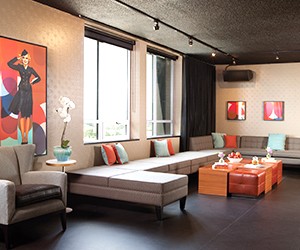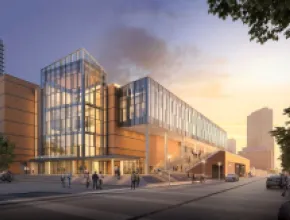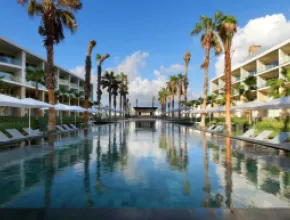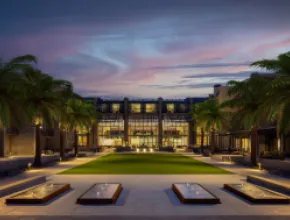Have a small group? Why not put them in a small hotel?
Most meeting destinations in the West have a solid selection of boutique properties—where the concept basically began--says Armel Reyes, director of national sales for Joie de Vivre Hospitality, a collection of thirty-odd boutique properties; all but one of which are in the West.
Start of it All
Joie de Vivre and competitor Kimpton Hotels & Restaurants practically invented the boutique market in the late 1970s and 1980s in San Francisco. The original idea was a small hotel, usually between two dozen and 200 rooms, created by renovating an older building. Smaller properties didn’t need the massive infrastructure and amenities that had become standard with global-brand properties. Instead of massive lobbies, they focused on personality and memorable employees.
The combination of sleek renovations, limited but highly personalized services, and an absolute sense of place were an instant hit with business travelers, meeting planners and leisure travelers. And it didn’t hurt that boutique pricing often undercut big brand competitors with larger staff, a larger ratio of public space to room space, higher operating costs and higher debt load.
Pros of the Properties
Pricing is important, but shaving a few dollars off of average rates isn’t the real reason planners go for boutique properties. Instead, meeting buyers go there for the kinds of experiences that no 1,000-room property can deliver.
“All of our properties are unique,” Reyes says. “If you are in a chain property, you can forget what city you’re in. That doesn’t happen in a boutique property.”
That makes meetings more memorable, he asserts.
“We attract companies that are doing something out of the box,” Reyes says. “The work of your event gets accomplished, but it is much more focused, much more relaxed and much more productive. And you will never forget where you are.”
Adds Kimpton’s vice president of sales Christine Lawson, “We don’t have hotels with floors and floors of meeting space. When you meet with us, your group isn’t going to get lost in the crowd for the simple reason that we don’t have the kind of space the lures crowds.
“That’s part of what makes a boutique property special,” she says.
Flat management structure is another given at boutique properties. Have a question or a problem? Chances are it can be handled on the spot.
“The ability to react quickly sets us apart,” says Zeena Fakouri, director of sales for the Cavallo Point Lodge, a 142-room property built into early 20th century U.S. Army officer quarters in Sausalito, across San Francisco Bay from San Francisco. “Nothing is mandated by corporate policy set in Chicago or New York, so we create solutions on the spot.”
Fakouri’s property has the advantage of featuring 29,000 square feet of indoor and outdoor space. Urban boutique properties may be limited to a few thousand square feet of group space, but there is no limit to the personalization or imagination that can be applied to an event.
“A boutique property is more nimble,” Lawson explains. “We can craft something unique more easily and quickly. For example, if you don’t want a standard classroom, how about an expanded living room?
“We have complete flexibility to talk about whatever it takes to make your meeting a success,” he says.
New Kid on the Block
Benchmark Hospitality International saw the boutique potential and jumped into the market in mid-2011 by acquiring MTM Personal Luxury Lodging, a luxury group based in Kirkland, Wash. A year later, there are 13 Personal Luxury Resorts & Hotels, from Hawaii to Florida.
“A classic meeting in a big-brand hotel is a stereotype,” says Ted Davis, senior vice president, sales and marketing at Benchmark. “Planners want to step outside that box. They know that a stimulating environment with stimulating activities can stimulate creative thinking.”
Location, Location, Location
Like most boutique operators, Benchmark downplays the group affiliation and plays up individual properties. Location is a key element in meeting design. Hotel 1000 plays off Seattle’s reputation as a technology hot spot with virtual golf. Attendees can play Pebble Beach or other top courses without ever leaving the property. A few blocks away, the Sorrento Hotel offers “Drinking Lessons,” an interactive icebreaker designed around spirits and cocktails.
Jason Farmer, director of sales for the 55-room Hotel Healdsburg in Healdsburg, Calif. plays off the hotel’s location in the heart of California’s Russian River Wine Country.
Food and wine are central themes of group entertainment and team building at the Healdsburg. Competitive wine making is a favorite activity.
Teams blend their own wines, design the labels, and bottle the result for an outside taste panel to judge.
Team cooking classes and competitions are another favorite. Celebrity Chef Charlie Palmer runs the Healdsburg’s restaurant, Dry Creek Kitchen, and can appear for cooking demos.
“We have had countless groups meet with us specifically because of Charlie’s name and his personal involvement,” Farmer says. “Groups can kayak on the Russian River, start the day with hot air ballooning and we can get exclusive access for our guests at wineries that just don’t open their doors to the public. That level of personal attention is the advantage of planning your event with a boutique hotel.”
Food is a point of emphasis at Kimpton’s hotels, too, Lawson says.
“Our take on food is a huge separation from the big brands,” she says. “We don’t have a restaurant chef and a banquet chef, we have a chef, and that person is intimately responsible for the preparation of food for our meetings.
“You get a food-driven meeting, not a rubber chicken meal,” she notes, “and that adds to the energy levels and the productivity of your attendees.”
Freelance writer Fred Gebhart believes boutique is beautiful.






